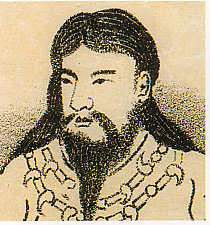Emperor Kaika
| Kaika | |
|---|---|
| Emperor of Japan | |
 | |
| Reign | legendary |
| Predecessor | Kōgen |
| Successor | Sujin |
| Born | legendary |
| Died | legendary |
| Burial | Kasuga no Izakawa no sak no e no misasagi (Nara) |
Emperor Kaika (開化天皇, Kaika-tennō); also known as Wakayamatonekohikooobi no Mikoto; is the ninth emperor of Japan,[1] according to the traditional order of succession.[2]
No firm dates can be assigned to this emperor's life or reign, but he is conventionally considered to have reigned from 157 BC–98 BC,[3] but he may have lived in the early 1st century.[4]
Legendary narrative
Modern scholars have come to question the existence of at least the first nine emperors; and Kaika's son Emperor Sujin is the first many agree might have actually existed, in third or fourth century.[5] The name Kaika-tennō was assigned to him posthumously by later generations.[6]
Kaika is regarded by historians as a "legendary emperor" and there is a paucity of information about him. There is insufficient material available for further verification and study.[7] The reign of Emperor Kimmei (509–571), the 29th emperor of Japan according to the traditional order of succession, is the first for which contemporary historiography are able to assign verifiable dates;[8] however, the conventionally accepted names and dates of the early emperors were not to be confirmed as "traditional" until the reign of Emperor Kammu (737–806), the 50th sovereign of the Yamato dynasty.[9]
In Kojiki and Nihonshoki, only his name and genealogy were recorded. The Japanese have traditionally accepted this sovereign's historical existence, and an Imperial misasagi or tomb for Kaika is currently maintained; however, no extant contemporary records have been discovered which confirm a view that this historical figure actually reigned. He was the eighth of eight emperors without specific legends associated with them, also known as the "eight undocumented monarchs" (欠史八代,, Kesshi-hachidai).[10]
Jien records that Kaika was the second son of Emperor Kōgen, and that he ruled from the palace of Isakawa-no-miya at Kasuga in what will come to be known as Yamato province.[11]

Kaika is a posthumous name. It is undisputed that this identification is Chinese in form and Buddhist in implication, which suggests that the name must have been regularized centuries after the lifetime ascribed to Kaika, possibly during the time in which legends about the origins of the Yamato dynasty were compiled as the chronicles known today as the Kojiki.[10]
The actual site of Kaika's grave is not known.[1] This emperor is traditionally venerated at a memorial Shinto shrine (misasagi) at Nara.
The Imperial Household Agency designates this location as Kaika's mausoleum. It is formally named Kasuga no Izakawa no sak no e no misasagi.[12]
Consorts and Children
Empress: Ikagashikome (伊香色謎命), daughter of Oohesoki (大綜麻杵)
- Prince Mimakiirihikoinie (御間城入彦五十瓊殖尊) (Emperor Sujin)
- Princess Mimatsuhime (御真津比売命)
Taniwa no Takanohime (丹波竹野媛), daughter of Taniwa no Ooagatanushi Yugori (丹波大県主由碁理)
- Prince Hikoyumusu (彦湯産隅命)
Hahatsuhime (姥津媛), younger sister of Washihime
- Prince Hikoimasu (彦坐王), great-grandfather of (Emperor Keikō), great2-grandfather of (Empress Jingū)
Washihime (鸇比売), daughter of katsuragi no Tarumi no Sukune (葛城垂見宿禰)
- Prince Taketoyohazurawake (建豊波豆羅和気王)
See also
Notes

- ^ a b Imperial Household Agency (Kunaichō): 開化天皇 (9)
- ^ Brown, Delmer et al. (1979). Gukanshō, p. 252; Varley, Paul. (1980). Jinnō Shōtōki, p. 93; Titsingh, Isaac. (1834). Annales des empereurs du japon, pp. 6-7., p. 6, at Google Books
- ^ Ponsonby-Fane, Richard. (1959). The Imperial House of Japan, p. 30.
- ^ Nussbaum, Louis-Frédéric. (2005). "Kaika Tennō" in Japan Encyclopedia, p. 451, p. 451, at Google Books; n.b., Louis-Frédéric is pseudonym of Louis-Frédéric Nussbaum, see Deutsche Nationalbibliothek Authority File.
- ^ "Life in the Cloudy Imperial Fishbowl," Japan Times. March 27, 2007.
- ^ Brinkley, Frank. (1915). A History of the Japanese People from the Earliest Times to the end of the Meiji Era, p. 21, p. 21, at Google Books; excerpt, "Posthumous names for the earthly Mikados were invented in the reign of Emperor Kammu (782-805), i.e., after the date of the compilation of the Records and the Chronicles.
- ^ Kelly, Charles F. "Kofun Culture," Japanese Archaeology. April 27, 2009.
- ^ Titsingh, pp. 34-36; Brown, pp. 261-262; Varley, pp. 123-124.
- ^ Aston, William. (1896). Nihongi, pp. 109.
- ^ a b Aston, William. (1998). Nihongi, Vol. 1, pp. 148-149.
- ^ Brown, p. 252.
- ^ Ponsonby-Fane, p. 418.
References
- Aston, William George. (1896). Nihongi: Chronicles of Japan from the Earliest Times to A.D. 697. London: Kegan Paul, Trench, Trubner. OCLC 448337491
- Brown, Delmer M. and Ichirō Ishida, eds. (1979). Gukanshō: The Future and the Past. Berkeley: University of California Press. 10-ISBN 0-520-03460-0; 13-ISBN 978-0-520-03460-0; OCLC 251325323
- Chamberlain, Basil Hall. (1920). The Kojiki. Read before the Asiatic Society of Japan on April 12, May 10, and June 21, 1882; reprinted, May, 1919. OCLC 1882339
- Nussbaum, Louis-Frédéric and Käthe Roth. (2005). Japan encyclopedia. Cambridge: Harvard University Press. 10-ISBN 0-674-01753-6; 13-ISBN 978-0-674-01753-5; OCLC 58053128
- Ponsonby-Fane, Richard Arthur Brabazon. (1959). The Imperial House of Japan. Kyoto: Ponsonby Memorial Society. OCLC 194887
- Titsingh, Isaac. (1834). Nihon Odai Ichiran; ou, Annales des empereurs du Japon. Paris: Royal Asiatic Society, Oriental Translation Fund of Great Britain and Ireland. OCLC 5850691
- Varley, H. Paul. (1980). Jinnō Shōtōki: A Chronicle of Gods and Sovereigns. New York: Columbia University Press. 10-ISBN 0-231-04940-4; 13-ISBN 978-0-231-04940-5; OCLC 59145842

